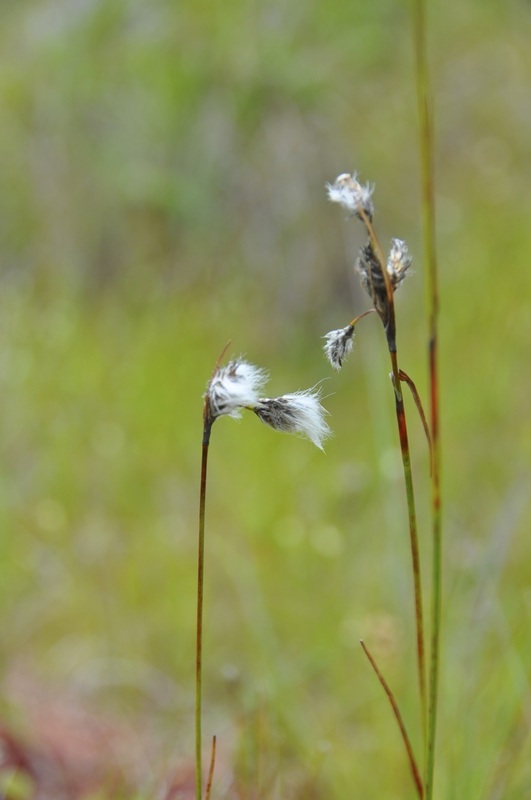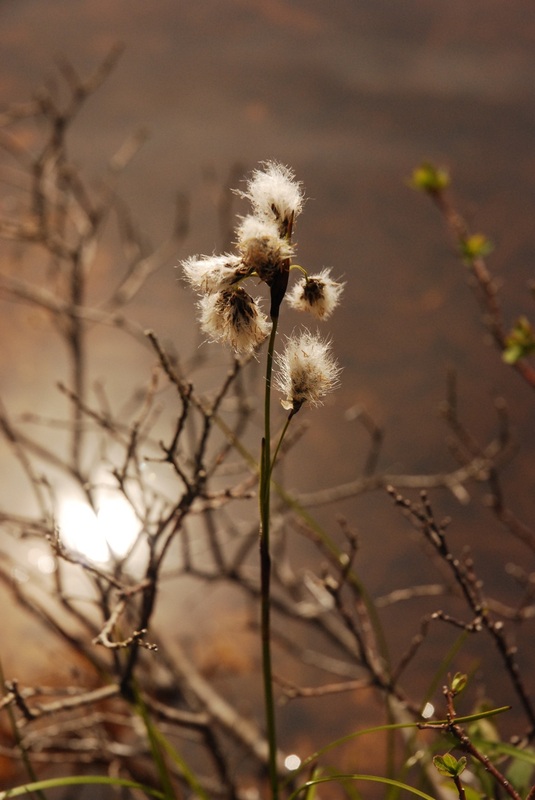Narrow-leaved cotton-grass, tall cotton-grass • Eriophorum angustifolium, E. polystachion
{Eriophorum = wool-bearer, angustifolium = narrow-leaved}
Narrow-leaved cotton-grass growing in boggy areas of Calvert Island. Photos by Kira Hoffman (left), Kelly Fretwell (centre), and Heather Polowyk (right).
Identification
This is a fairly distinctive species of 'grass' (it is actually a sedge) when it is in fruit. Its main identifying feature is the white cotton-like tufts, a few centimetres long, that clump at the top off each stem. The tufts are composed of bristles that surround the brownish-grey seeds, and help with wind-driven seed dispersal. Other identifying features are the extensively-spreading rhizomes from which one to a few stems arise, the presence of leaves at the base and along the stem, and the two or more leaf-like bracts that stick up around and past the inflorescence.
A more detailed identification is available on the E-Flora species page.
Habitat & Range
Narrow-leaved cotton-grass is a characteristic species of nutrient-poor wetlands. It grows in and around marshes, bogs, fens, stream-banks, shorelines, and wet meadows. It is a widespread and common species along the coast of BC, and can be found from low to high elevations. This circumpolar species is found throughout Canada, the northern United States, and Eurasia.
Similar Species
Many other species of cotton-grass are found in BC, but most do not occur along the coast. Chamisso's cotton-grass (Eriophorum chamissonis) is found along the coast at low to middle elevations, but the cinnamon colour of its bristles distinguishes it from narrow-leaved cotton-grass.
This is a fairly distinctive species of 'grass' (it is actually a sedge) when it is in fruit. Its main identifying feature is the white cotton-like tufts, a few centimetres long, that clump at the top off each stem. The tufts are composed of bristles that surround the brownish-grey seeds, and help with wind-driven seed dispersal. Other identifying features are the extensively-spreading rhizomes from which one to a few stems arise, the presence of leaves at the base and along the stem, and the two or more leaf-like bracts that stick up around and past the inflorescence.
A more detailed identification is available on the E-Flora species page.
Habitat & Range
Narrow-leaved cotton-grass is a characteristic species of nutrient-poor wetlands. It grows in and around marshes, bogs, fens, stream-banks, shorelines, and wet meadows. It is a widespread and common species along the coast of BC, and can be found from low to high elevations. This circumpolar species is found throughout Canada, the northern United States, and Eurasia.
Similar Species
Many other species of cotton-grass are found in BC, but most do not occur along the coast. Chamisso's cotton-grass (Eriophorum chamissonis) is found along the coast at low to middle elevations, but the cinnamon colour of its bristles distinguishes it from narrow-leaved cotton-grass.
References
Eriophorum angustifolium Honck. In Klinkenberg, Brian. (Ed.). E-Flora BC: Electronic Atlas of the Plants of British Columbia. Lab for Advanced Spatial Analysis, Department of Geography, University of British Columbia, Vancouver. Accessed 21/08/2013.
Pojar, J. and MacKinnon, A. (1994). Plants of Coastal British Columbia. Vancouver, BC: Lone Pine Publishing. P. 407.
Authors and editors of page
Kelly Fretwell and Brian Starzomski (2013).
Eriophorum angustifolium Honck. In Klinkenberg, Brian. (Ed.). E-Flora BC: Electronic Atlas of the Plants of British Columbia. Lab for Advanced Spatial Analysis, Department of Geography, University of British Columbia, Vancouver. Accessed 21/08/2013.
Pojar, J. and MacKinnon, A. (1994). Plants of Coastal British Columbia. Vancouver, BC: Lone Pine Publishing. P. 407.
Authors and editors of page
Kelly Fretwell and Brian Starzomski (2013).






